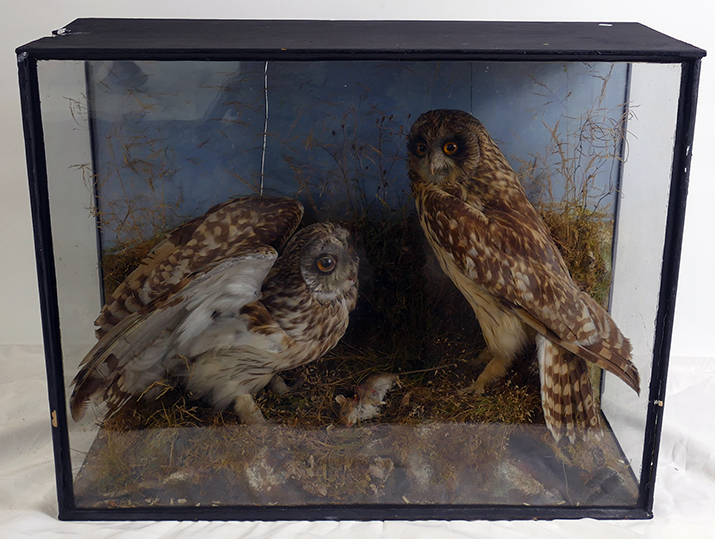
Early 20th Century Taxidermy model of a pair of Tawney Owls – In wooden case with glass. 47cm high x 59cm long x 23cm deep. This lot fetched £95 at auction.
Our ‘Words of Wisdom’ today are from local antiques auctioneers Louis Taylors who are going to touch on Taxidermy in the world of antiques.
Taxidermy – long deceased creatures lurking in dusty, dark looking cases! Did you know there were more than a dozen taxidermists exhibiting at the Great Exhibition in 1851? The subject flourished from this point right through to the 1930s before starting a slow decline during the 20th Century.
The genteel and practiced art of having ones animals, birds and fish stuffed and mounted, often then placed in fine, cabinet maker produced cases, has largely, but not entirely died out (please forgive the unintended pun).
During the last 30 years however, we have seen a slow but steady increase in the revival of the art. The Victorians and Edwardians were great ‘stuffers’ of everything from Big Game heads to specimen fish and almost everything in between, it seems.
The market for good, original, old items of taxidermy is extremely buoyant. We stress OLD, because in particular with the fish, enterprising, predominantly Asian factories have been quietly importing fakes into the country for some years. Fortunately they are quite easy to spot, and can often be seen at car boot sales and markets, with a generally vague description attached.
However, the original pieces are very much in demand, in particular by named taxidermists. Collectors of antique specimens prefer named cases by the best makers. It is not an exhaustive list but the best examples of antique taxidermy often carry the labels of Cooper of London, Henry and Rowland Ward of Piccadilly, James Hutchings of Aberystwyth, James Gardner of London, Thomas Gunn of Norwich, A.S Hutchinson of Derby, Jefferies & Sons of Carmarthen, Murray of Carnforth, H.T. Shopland of Torquay and Peter Spicer of Leamington Spa.

A cased Victorian Taxidermy Scene of a little Ringed Plover / Sanderling set in woodland, 41cm length x 27cm depth & 37cm height. This fetched £80 in our November 2019 sale.
Quality and condition of the subject specimen is of paramount importance, as of course is the subject matter. Some specimens can make well into the thousands of pounds, and even a basic fish in a nice bowed glass case will sell for hundreds of pounds. Rare and large specimens can fetch prices of over £1000.
A final word on the subject, often incorrectly undervalued are original carved and painted wooden studies of fish. These pieces usually depict salmon and represent a specimen fish that has either been caught and released, eaten, or more likely stuffed. Originals are extremely sought after often topping the £1000 mark and well beyond.
If you have a piece that you would like valuing then please get in touch with our team who will be happy to help, or drop by one of our valuation days.
A note on restricted items
We can advise and guide you through the process in identifying a small number of restricted or banned items, and undertake the steps to ensure all aspects are attended to in order to comply with current legislation, laws and rulings by Cities, the overseeing governing body concerned.
Selling at Auction
If you have collectible pieces you’re looking to sell, Call 01782 638100 or emailenquiries@potteriesauctions.com to book a valuation appointment to attend one of our Tuesday valuation days. We also provide valuations via WhatsApp, simply send some clear photographs of your items via the app to 07864 667940. Additionally, we can send you links to our catalogues via WhatsApp–message the above number via the app and ask to receive our catalogues. Make sure you are subscribed to our email newsletters, too!
